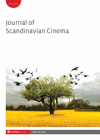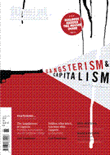
Cinemas d Amerique Latine
Scope & Guideline
Fostering Scholarly Dialogues on Latin American Cinematic Art
Introduction
Aims and Scopes
- Exploration of Latin American Cinema History:
The journal extensively covers historical perspectives on Latin American cinema, analyzing significant movements, key filmmakers, and the evolution of film industries across different countries. - Cultural and Social Impact of Cinema:
It examines how cinema interacts with cultural identities, societal issues, and political contexts, often addressing themes such as colonialism, feminism, and social justice. - Interviews and Filmmaker Insights:
The journal features interviews with prominent filmmakers and industry figures, providing unique insights into their creative processes, challenges, and perspectives on the cinematic landscape. - Theoretical and Critical Analysis:
A strong emphasis is placed on critical theory and analytical frameworks that explore narrative structures, aesthetics, and audience reception within Latin American cinema. - Focus on Emerging Filmmakers and Genres:
The journal highlights the works of emerging filmmakers and new genres, particularly those that challenge traditional narratives and represent marginalized voices.
Trending and Emerging
- Videoactivism and Social Movements:
There is a growing interest in video activism and its role in social movements, reflecting the impact of digital media in shaping political narratives and civic engagement. - Gender Perspectives in Cinema:
A significant increase in discussions surrounding gender representation, particularly focusing on female directors and their contributions, highlights an emerging trend towards inclusivity and diversity in cinematic narratives. - Transnational Cinema Studies:
The exploration of transnational cinema, including cross-cultural influences and collaborations, has gained traction, indicating a shift towards understanding cinema in a globalized context. - Restoration and Preservation of Film Archives:
Recent themes emphasize the importance of restoring and preserving Latin American film archives, recognizing the cultural significance of historical films in contemporary discourse. - Thematic Exploration of Horror and Gothic Genres:
There is an emerging focus on horror and gothic genres within Latin American cinema, examining how these genres relate to cultural anxieties and societal issues.
Declining or Waning
- Traditional Cinema Narratives:
There has been a noticeable decrease in articles centered around traditional narratives and mainstream commercial cinema, suggesting a shift towards more experimental and avant-garde film practices. - Historical Documentaries:
Although historical documentaries have been a significant part of the journal's discourse, recent publications show a waning interest in this area, possibly as filmmakers explore more contemporary issues. - Focus on Specific National Cinemas:
The journal seems to be moving away from in-depth studies of specific national cinemas in favor of broader regional or transnational analyses, indicating a decline in localized studies.
Similar Journals

Hrvatski Filmski Ljetopis
Fostering Dialogue in Film Studies.Hrvatski Filmski Ljetopis, published by the Croatian Film Clubs Association, serves as a pivotal academic journal in the field of film studies, celebrating and analyzing the rich cinematic heritage of Croatia and beyond. With an ISSN of 1330-7665, this journal caters to researchers, practitioners, and students who are passionate about the art of filmmaking, encompassing both theoretical discourse and practical implications. Although it is not currently available as an open-access publication, its curated content is of significant value to anyone interested in the evolution, critique, and history of film in a Croatian context, having previously been indexed in Scopus until coverage was discontinued. The journal operates out of Zagreb, Croatia, at the Croatian Film Clubs Association headquarters, and aims to foster scholarly dialogue while contributing to the broader field of national and international cinematography.

Historia-Santiago
Engaging with Diverse Perspectives on Historical ContextsHistoria-Santiago is an esteemed academic journal published by the Pontificia Universidad Católica de Chile, Instituto de Historia. Since its inception in 2000, the journal has embraced an Open Access model, facilitating broad dissemination of historical research and ensuring that critical scholarly work is freely accessible to researchers, professionals, and students around the globe. With a focus on Latin American history, Historia-Santiago provides a platform for innovative research and contributions that engage with diverse historical narratives and methodologies. The journal aims to foster interdisciplinary dialogue and stimulate scholarly debate, thereby enriching the understanding of historical contexts and their implications in contemporary society. By maintaining high academic standards, Historia-Santiago occupies a vital role in the field of historical studies, encouraging authors to explore new ideas and perspectives that shape the understanding of our past.

E-Latina-Revista Electronica de Estudios Latinoamericanos
Advancing Knowledge Through Open Dialogue on Latin American IssuesE-Latina-Revista Electronica de Estudios Latinoamericanos is a premier open-access journal dedicated to the interdisciplinary study of Latin American culture, society, and politics. Published by the Facultad de Ciencias Sociales at the Universidad de Buenos Aires, this journal aims to provide a platform for the dissemination of high-quality research, facilitating an exchange of ideas among scholars, practitioners, and students alike since its inception in 2013. With its commitment to accessibility, E-Latina makes significant contributions to the understanding of contemporary Latin American issues, inviting contributions from a diverse range of academic fields. Its open-access model not only enhances readership but also ensures that vital knowledge reaches a global audience, thereby promoting scholarly dialogue and collaboration. Researchers interested in the dynamic and evolving landscape of Latin America will find a wealth of research and insights that reflect the complexities of the region in this esteemed publication.

Journal of Scandinavian Cinema
Celebrating the Rich Tapestry of Scandinavian CinemaThe Journal of Scandinavian Cinema, established in 2014 and published by INTELLECT LTD, serves as a premier platform dedicated to the interdisciplinary field of film studies with a specific focus on Scandinavian cinema. With an impressive Q2 category ranking in Visual Arts and Performing Arts for 2023, and a Scopus rank placing it in the top 62nd percentile of its category, this journal is instrumental in advancing scholarly dialogue within the arts community. The journal strives to explore and critique cinematic expressions from the Nordic countries, contributing to a nuanced understanding of cultural narratives and filmic innovations. Committed to fostering accessibility and engagement, it caters to a diverse audience including researchers, professionals, and students keen to delve into the artistic, cultural, and political dimensions of cinema. The Journal of Scandinavian Cinema is essential for anyone interested in the evolution and impact of film in the Scandinavian context, promising rich insights and a robust collection of scholarly articles.

Film International
Diving Deep into the World of Film and Its Narratives.Film International is a prominent journal dedicated to the exploration of film and its cultural, social, and artistic significance. Published by INTELLECT LTD, this journal serves as a platform for interdisciplinary studies in the field of film criticism, theory, and scholarship, contributing valuable insights from both established and emerging researchers. With an ISSN of 1651-6826 and an E-ISSN of 2040-3801, the journal is an essential resource for those engaged in the realms of communication, cultural studies, and visual arts, though it is currently classified in the lower quartiles of these fields (Q4). Noteworthy for its critical perspectives and diverse content, Film International enhances the dialogue surrounding cinematic practices and their impact on society. Researchers, professionals, and students can explore its rich assemblage of articles and reviews that reflect the evolving landscape of film studies, making it a significant addition to the academic community focused on the art of film.

FILM CRITICISM
Illuminating the Frames of Film CritiqueFILM CRITICISM is a prestigious open-access journal dedicated to the study and review of cinema, offering a platform for scholars, critics, and students to engage deeply with the evolving landscape of film. Published by Film Criticism and based in the United States at Allegheny College, this journal has been contributing to film studies since 2002, with recent issues spanning from 2023 to 2024. Registered under ISSN 0163-5069, it is recognized in the Visual Arts and Performing Arts categories, achieving a commendable rank of #372 out of 667 in Scopus, placing it in the 44th percentile of its field. With an open-access policy implemented since 2016, FILM CRITICISM not only broadens accessibility to scholarly work but also enhances the dialogue around cinematic narratives, theories, and critiques. The journal's relevance is underscored by its current Q3 ranking, making it an essential resource for researchers and professionals alike who are invested in the critical examination of film.

SIGHT AND SOUND
Engaging Minds Through the Lens of FilmSIGHT AND SOUND is a prestigious journal published by the British Film Institute, dedicated to the exploration of cinema and its cultural significance. With an ISSN of 0037-4806 and an E-ISSN matching the same, this journal has been a critical platform for film studies since its inception, contributing valuable insights to the realms of visual arts and performing arts. Despite its discontinuation in the Scopus database post-2021, SIGHT AND SOUND commands respect within its field, currently holding a Q3 rank among Visual Arts and Performing Arts journals. Operating from 21 Stephen Street, London W1P 1PL, England, it serves as a vital resource for researchers, professionals, and students looking to deepen their understanding of film theory, critique, and history. While access to its articles is not open, the journal continues to influence the discourse in film studies, making it a significant asset in academic and professional circles.

French Screen Studies
Charting New Frontiers in Film and Media StudiesFrench Screen Studies is a distinguished journal published by Routledge Journals, Taylor & Francis Ltd, focusing on the dynamic interactions between film, media, and cultural studies within the context of French cinema. Since its inception in 2020, the journal has contributed significantly to the academic landscape, providing a platform for innovative research and critical discussion on visual arts and performance as reflected in its prestigious Q1 ranking in Visual Arts and Performing Arts for 2023. Despite being a burgeoning journal, it holds an impressive position within Scopus rankings, particularly in the Arts and Humanities sphere. Researchers and scholars will find the journal a vital resource, as it endeavors to explore the intersections of screen studies with broader social and cultural implications. Although currently not open access, French Screen Studies continues to foster an inclusive dialogue among academics, paving the way for future exploration of France’s influential cinematic heritage.

CINEJ Cinema Journal
Unveiling the Dynamics of Cinema Studies.CINEJ Cinema Journal, published by the University of Pittsburgh Library System, stands as a pivotal platform for scholarly discourse in the dynamic field of cinema studies. With an ISSN of 2159-2411 and an E-ISSN of 2158-8724, this Open Access journal has been dedicated to disseminating high-quality research since its inception in 2011. CINEJ provides an essential resource for researchers, practitioners, and students alike, exploring varied dimensions of cinema, including its cultural, historical, and technological implications. The journal is committed to fostering interdisciplinary dialogue, making it a vital asset for those seeking to deepen their understanding of cinema as an art form and social phenomenon. By engaging with contemporary issues and trends in the cinematic landscape, CINEJ encourages contributions that illuminate the intersection of film and social inquiry, ensuring its relevance in today’s academic ecosystem.

Acta Literaria
Illuminating the Rich Tapestry of Literary StudiesActa Literaria is a distinguished journal published by the Universidad de Concepción, Facultad de Humanidades y Arte, focusing on the intricate domains of literature and literary theory. With an ISSN of 0717-6848, this Chilean journal has been a vital contributor to the scholarly discourse in its field since its inception in 2007. Although currently categorized in the Q4 quartile for the year 2023 and holding a Scopus rank of #860 out of 1106 in the Arts and Humanities section, Acta Literaria plays a crucial role in fostering dialogue and exploration among researchers, professionals, and students alike. The journal aims to facilitate the exchange of innovative ideas, critical analyses, and diverse perspectives on literature, making it an indispensable resource for anyone engaged in literary studies. While it does not offer open access, the journal's commitment to upholding academic rigor ensures that it remains a respected platform for scholarly publication.